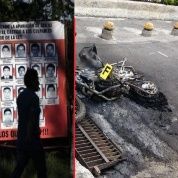In Venezuela in February and March some opposition supporters and people paid by certain opposition leaders set up barricades around the country and called for the “exit” of democratically elected President Maduro. These violent barricades saw people standing on top of apartment buildings and aiming rifles at people crossing at a main intersection, driving by on motorbikes as communities tried to clear the barricades so they could get to work or school and shooting and killing people those people, wire traps decapitating motorists, and effigies of Chavistas hung from bridges. Chavistas and the poor were taunted, threatened with death and rape, community organizers were beaten up, including my friend and his whole family, they shot at journalists, set fire to garbage at barrio entrances, prevented millions from accessing cooking gas, bread, and other basic supplies, burned scores of public buses, a childcare center, health care centers, and the environment ministry, stopped millions of children from attending school, and prevented people from accessing life saving medicine including diabetes injections. In that context, 43 people were killed, and thousands more were injured and suffered from the psychological effects of the violent blockades. Of the 43, five were killed by security forces, and those police and soldiers were tried and sent to prison.

But organized families of the Venezuelan victims are still calling for justice; for recognition from international organizations.
In Mexico, the 43 students who were kidnapped and possibly killed have received deserved empathetic coverage from even the most conservative media. CNN has given their situation a lot of news time, the Huffington Post described their ordeal in a headline as “Truly Terrifying” and the Christian Science Monitor, like most private media, has referred to families' “hope”, the “need for justice,” and that the criminals “should be arrested.”
In contrast, the mainstream and private media ignored, or demonized the victims of both psychological and physical violence in Venezuela. Social organizations, or collectives, were described over and over as “violent,” rather than as victims. The Huffington Post talked about “pro-Maduro gangs terroriz(ing) Venezuelans” and USA Today linked social organizations and Chavistas to “paramilitaries.”
Unlike Mexico, Cuba and Venezuela are seen as a challenge to the West's economic model and unilateral dominance of regional politics.
The media dehumanized Venezuela's 43 dead, especially the majority of those who were not opposition supporters, and criminalized them, while portraying the perpetrators of the violence as “peaceful protestors.”
In February and March, 162 Cuban doctors in Venezuela were also attacked by opposition supporters. Two of them were almost burnt alive in an attack on a medical center in Lara. The mainstream media never covered it. It instead covered the so-called Cuban “interference” in Venezuelan politics, interestingly, not taking this line towards the recent Cuban medical assistance in Sierra Leone. This is because unlike Mexico and Sierra Leone, Cuba and Venezuela are seen as a challenge to the West's economic model and unilateral dominance of regional politics.
Further, while the mainstream has used “human rights” discourse for the Mexican 43 and objectively reported on the arrest of the Iguala mayor and his wife for being the masterminds behind the kidnappings, it took the opposite attitude towards the San Cristobal mayor in Venezuela who openly supported the violent barricades. For the mainstream media, the mayor Daniel Ceballos, and opposition leader Leopoldo Lopez, are heroes and victims of political persecution. The Washington Post for example, in an article headlined “Jailed leader channels Venezuelans’ ire,” portrayed Lopez as brave, and did not once mention the Venezuelan deaths.
Similarly, while the mainstream media usually ignores or demonizes protest movements, it has been uncharacteristically sympathetic to the protests against the lack of government action around the disappearances in Mexico; though this will likely change as those protests radicalize. The Wall Street Journal went as far as to celebrate that the Ayotzinapa teachers college campus is “festooned with murals of Marx, Lenin and Che Guevara as well as Mexican revolutionaries—including several of the school’s alumni," and the Guardian has published full protester accounts as to why they are marching. The BBC's coverage of the protests in Mexico has been regular and gentle.
In contrast, the recent Venezuelan committee organized to call for justice for Venezuela's 43 dead has received no coverage, nor did mass Chavista marches which occurred on a weekly basis in February and March.
While the private media will profit from the sensationalist gains of reporting on victims of violent crimes, it will never factually report on strongly organized resistance. The difference in its coverage of Venezuela's 43 and Mexico's 43 is because while Ayotzinapa is the rage of the world's invisible people, sick of being so easily dispensable, so easy to kill, of the rich and the powerful lording it over the world, bombing, invading, destroying, and disappearing with complete immunity, Venezuela is politics and power. Venezuela is complicated. It’s a whole government with millions of people in the country organized into communal councils and other organizations, that together have vindicated the invisible people. And for the spineless mainstream media (run by the powerful), that is too much.